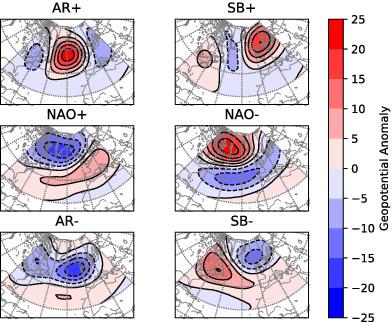当前位置:
X-MOL 学术
›
Q. J. R. Meteorol. Soc.
›
论文详情
Our official English website, www.x-mol.net, welcomes your feedback! (Note: you will need to create a separate account there.)
Revisiting the identification of wintertime atmospheric circulation regimes in the Euro‐Atlantic sector
Quarterly Journal of the Royal Meteorological Society ( IF 8.9 ) Pub Date : 2020-06-14 , DOI: 10.1002/qj.3818 Swinda K.J. Falkena 1 , Jana Wiljes 1, 2 , Antje Weisheimer 3, 4 , Theodore G. Shepherd 5
Quarterly Journal of the Royal Meteorological Society ( IF 8.9 ) Pub Date : 2020-06-14 , DOI: 10.1002/qj.3818 Swinda K.J. Falkena 1 , Jana Wiljes 1, 2 , Antje Weisheimer 3, 4 , Theodore G. Shepherd 5
Affiliation

|
Atmospheric circulation is often clustered in so‐called circulation regimes, which are persistent and recurrent patterns. For the Euro‐Atlantic sector in winter, most studies identify four regimes: the Atlantic Ridge, Scandinavian Blocking and the two phases of the North Atlantic Oscillation. These results are obtained by applying k‐means clustering to the first several empirical orthogonal functions (EOFs) of geopotential height data. Studying the observed circulation in reanalysis data, it is found that when the full field data are used for the k‐means cluster analysis instead of the EOFs, the optimal number of clusters is no longer four but six. The two extra regimes that are found are the opposites of the Atlantic Ridge and Scandinavian Blocking, meaning they have a low‐pressure area roughly where the original regimes have a high‐pressure area. This introduces an appealing symmetry in the clustering result. Incorporating a weak persistence constraint in the clustering procedure is found to lead to a longer duration of regimes, extending beyond the synoptic time‐scale, without changing their occurrence rates. This is in contrast to the commonly used application of a time‐filter to the data before the clustering is executed, which, while increasing the persistence, changes the occurrence rates of the regimes. We conclude that applying a persistence constraint within the clustering procedure is a better way of stabilizing the clustering results than low‐pass filtering the data.
中文翻译:

再次确定欧洲大西洋地区冬季的大气环流制度
大气环流通常聚集在所谓的环流体系中,这种环流是持续不断的模式。对于冬季的欧洲大西洋板块,大多数研究都确定了四个区域:大西洋海岭,斯堪的纳维亚阻塞和北大西洋涛动的两个阶段。通过将k均值聚类应用于地势高度数据的前几个经验正交函数(EOF),可以获得这些结果。在重新分析数据中研究观测到的环流,发现当全场数据用于k-表示聚类分析而不是EOF,聚类的最佳数目不再是四个,而是六个。发现的另外两个区域是大西洋海岭和斯堪的纳维亚阻塞的对立面,这意味着它们的低压区域大致与原始区域的高压区域相同。这在聚类结果中引入了吸引人的对称性。发现在聚类过程中加入弱的持久性约束会导致更长的政权持续时间,超出天气的时间尺度,而不会改变其发生率。这与在执行聚类之前在数据上通常使用时间过滤器相反,后者在增加持久性的同时,会改变状态的发生率。
更新日期:2020-06-14
中文翻译:

再次确定欧洲大西洋地区冬季的大气环流制度
大气环流通常聚集在所谓的环流体系中,这种环流是持续不断的模式。对于冬季的欧洲大西洋板块,大多数研究都确定了四个区域:大西洋海岭,斯堪的纳维亚阻塞和北大西洋涛动的两个阶段。通过将k均值聚类应用于地势高度数据的前几个经验正交函数(EOF),可以获得这些结果。在重新分析数据中研究观测到的环流,发现当全场数据用于k-表示聚类分析而不是EOF,聚类的最佳数目不再是四个,而是六个。发现的另外两个区域是大西洋海岭和斯堪的纳维亚阻塞的对立面,这意味着它们的低压区域大致与原始区域的高压区域相同。这在聚类结果中引入了吸引人的对称性。发现在聚类过程中加入弱的持久性约束会导致更长的政权持续时间,超出天气的时间尺度,而不会改变其发生率。这与在执行聚类之前在数据上通常使用时间过滤器相反,后者在增加持久性的同时,会改变状态的发生率。



























 京公网安备 11010802027423号
京公网安备 11010802027423号